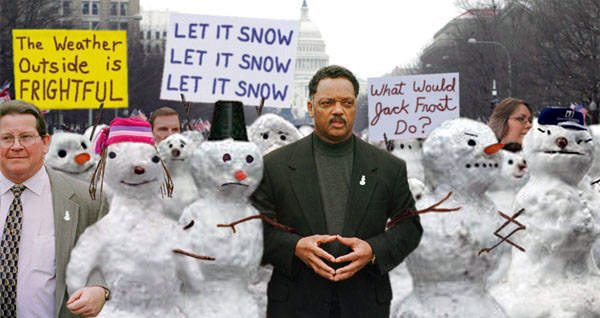Entries in Ecology, Conservation (6)
Snowmen March Against Global Warming
 Snowmen from across the nation gather at the Washington Monument to protest global warming.
Snowmen from across the nation gather at the Washington Monument to protest global warming.
WASHINGTON, DC—Braving balmy temperatures and sunny skies, millions of scarfless snowmen and snowwomen gathered in cities across the world Monday to raise public awareness about the heavy toll global warming is taking on their health and well-being.
According to organizers of marches in Washington, Atlanta, Montreal, Berlin, London, Reykjavik, and Moscow, global warming is the primary cause of the steep reduction in the snowman population throughout the Northern Hemisphere. Demonstrators worldwide called on their governments to take more aggressive steps to reduce the effects of climate change.
Organizers estimated the crowd at more than 375,000, but D.C. Police Commissioner Charles Stacey estimated turnout at 30,000 whole snowmen, with scattered rounded abdomens accounting for an additional 5,000. Atlanta organizers and police agree that all demonstrators had melted by 11 a.m.
Considering a "Living" Christmas Tree?
If you’ve never enjoyed a “living” Christmas tree, you might want to consider it. The idea is that, by buying a living tree for your home and then planting it after the holidays, you’re not only “saving a tree,” you’re helping landscape your yard. Some of us, though, shy away from decorating green because we think it’s too much work or we’re not sure how to plant the thing once we remove all the ornaments.
Granted, a living tree is heavy, what with the root ball and all. Lugging it into and out of the house takes some ingenuity and maybe a couple strong friends. But the big question remains, “How do you plant a Christmas tree?” Well, don’t fret. Here’s a primer from the good folks at Growing Wisdom:
Artist Wants His Tail Off California Plates
 The Laguna Beach artist who created California’s iconic whale-tail license plate is making a splash with state coastal officials, revoking the state’s right to use his art after they snubbed his request to share profits from the image with his environmental group.
The Laguna Beach artist who created California’s iconic whale-tail license plate is making a splash with state coastal officials, revoking the state’s right to use his art after they snubbed his request to share profits from the image with his environmental group.
Wyland, the marine muralist whose paintings of ocean life envelop buildings around the world, let the state use his hazy blue image of a whale’s flukes for environmentally themed license plates fourteen years ago in what state officials describe as a “handshake deal.” But Wyland says he allowed the use of his image for environmental causes for a period of time and that the time is up unless an agreement can be reached.
California earns about $3.77 million a year from the plates, but the Coastal Commission receives only a third of the funds: about $15 for each new plate sold; roughly $1.4 million a year. The rest goes to other state environmental programs. According to Coastal Commission Executive Director Peter Douglas, Wyland gave his image to the state unconditionally. Not so, says Wyland. Read the full story
Personally, I think Wyland may have erred in not getting something in writing at the onset and then waiting fourteen years to press the issue. What’s likely to happen? IMO, Wyland will either take the offer the Commission claims to have offered, or we’ll soon see a different whale tail on our license plates.
Happy Earth Day
Got this from Felix…

Earth Day 2008
 Today is Earth Day, the April 22nd one, not to be confused with the Equinox Earth Day in March or the Earth Hour, also in March, or any of the various World Days (World Day for Water, World Day for Cultural Diversity, World Jump Day, et al). Each year, the April 22 Earth Day marks the anniversary of the birth of the modern environmental movement in 1970.
Today is Earth Day, the April 22nd one, not to be confused with the Equinox Earth Day in March or the Earth Hour, also in March, or any of the various World Days (World Day for Water, World Day for Cultural Diversity, World Jump Day, et al). Each year, the April 22 Earth Day marks the anniversary of the birth of the modern environmental movement in 1970.
Among other things, 1970 in the United States brought with it the Kent State shootings, the advent of fiber optics, “Bridge over Troubled Water,” Apollo 13, the Beatles’ last album, the death of Jimi Hendrix, and the meltdown of fuel rods in the Savannah River nuclear plant near Aiken, South Carolina — an incident not acknowledged for 18 years. At the time, Americans were slurping leaded gas through massive V8 sedans, industry belched out smoke and sludge with little fear of legal consequences or bad press, and air pollution was commonly accepted as the smell of prosperity. “Environment” was a word that appeared more often in spelling bees than on the evening news.
But Earth Day 1970 turned that all around, thrusting the environment onto the national agenda. On April 22, 20 million Americans took to the streets, parks, and auditoriums to demonstrate for a healthy, sustainable environment.
Earth Day 1990 mobilized 200 million people in 141 countries and lifted the status of environmental issues onto the world stage, giving a huge boost to recycling efforts worldwide and helping pave the way for the 1992 United Nations Earth Summit in Rio de Janeiro. Earth Day 2000 combined the big-picture feistiness of the first Earth Day with the international grassroots activism of Earth Day 1990. Using the Internet to help link 5,000 environmental groups in a record 184 countries, it sent the message loud and clear that citizens around the world wanted quick and decisive action on clean energy. And Earth Day 2007 was one of the largest Earth Days to date, with an estimated billion people participating in the activities world wide.
Today, Earth Day Network reaches over 17,000 organizations in 174 countries, while the domestic program engages 5,000 groups and over 25,000 educators coordinating millions of community development and environmental protection activities throughout the year. Notable is that Earth Day is the only event celebrated simultaneously around the globe by people of all backgrounds, faiths and nationalities with more than a half billion people participating in Earth Day Network campaigns every year.
Who cares? Well, we all should. We can argue whether the pendulum has swung too far or not yet far enough, but we all agree that environmental issues command an important place on the world agenda and that we all share responsibility for the proper care and feeding of Mother Earth.
By the way, what ever happened to Captain Planet and the Planeteers? Did environmental extremists (or Turner) render them irrelevant? Anyone?
Polar Bear Conservancy to Relocate Polar Bears
Get your checkbooks ready! Here’s one more…
According to The Polar Bear Conservancy Media Center:
The program is expected to cost $30 million U.S., or approximately $10,000 U.S. per polar bear. The Polar Bear Conservancy has raised the first $15 million from corporate donors and is seeking additional funding through industry and government partnerships.
“This innovative private program will save taxpayers dollars billions of dollars that would otherwise be wasted on unnecessary habitat protection and economically ruinous strategies designed to combat so-called climate change,” said Grover Norquist, president of Americans for Tax Reform.”
The first batch of polar bears will be released on the edge of the Ross Sea near emperor penguin colonies trapped by the recent movement of giant icebergs C16 and B15A. “These penguins would starve to death anyway,” said Polar Bear Conservancy staff biologist Jon Heidenberg. “Now they can provide an initial source of food for the polar bears while they acclimate to their new environment.”





